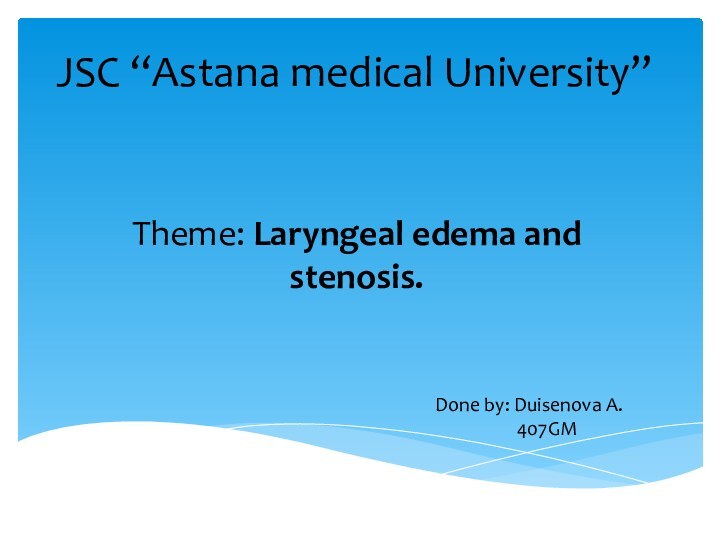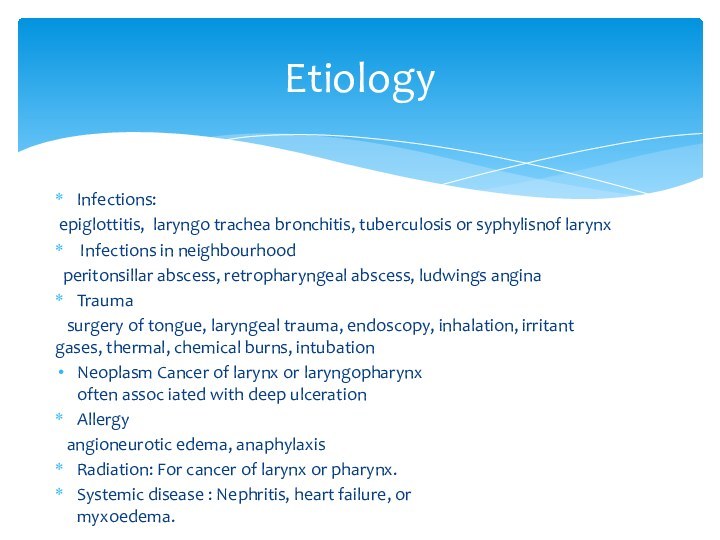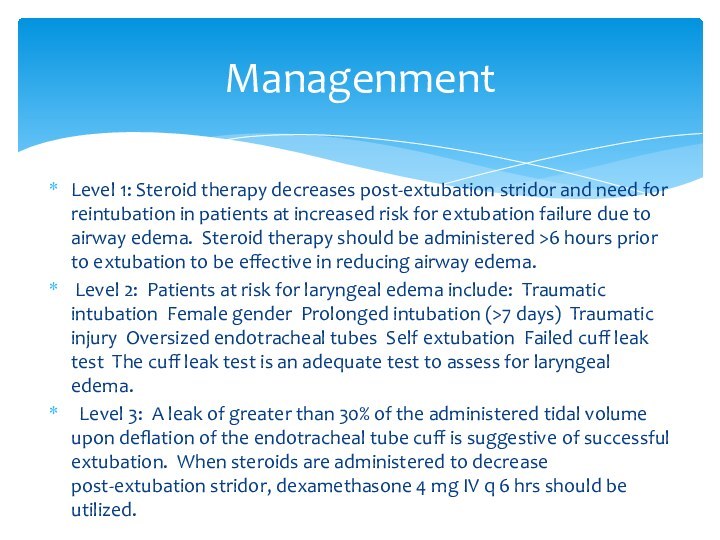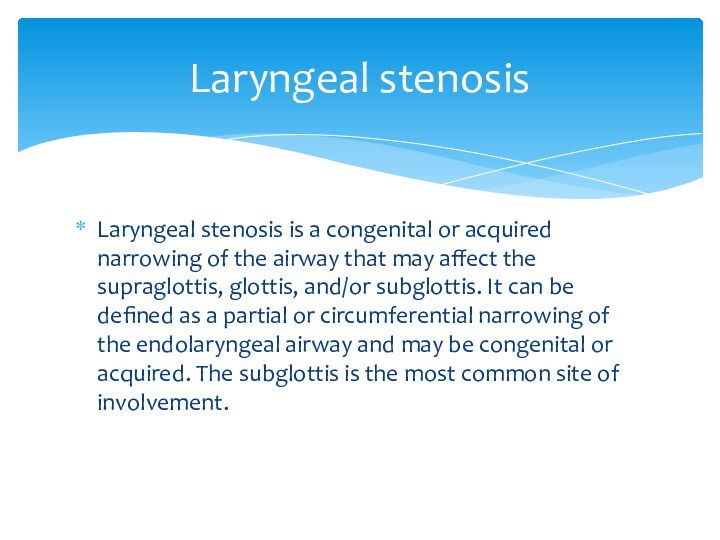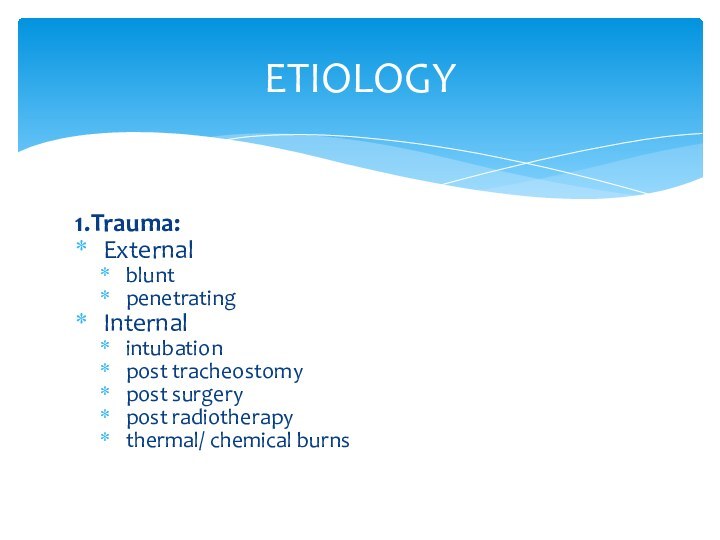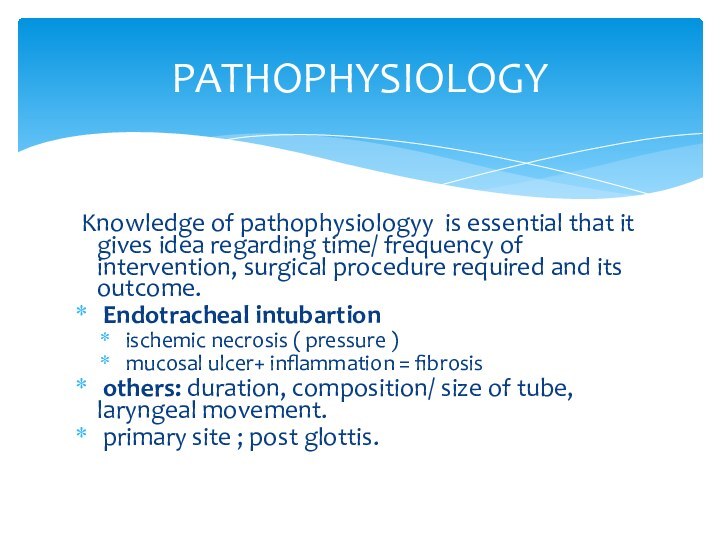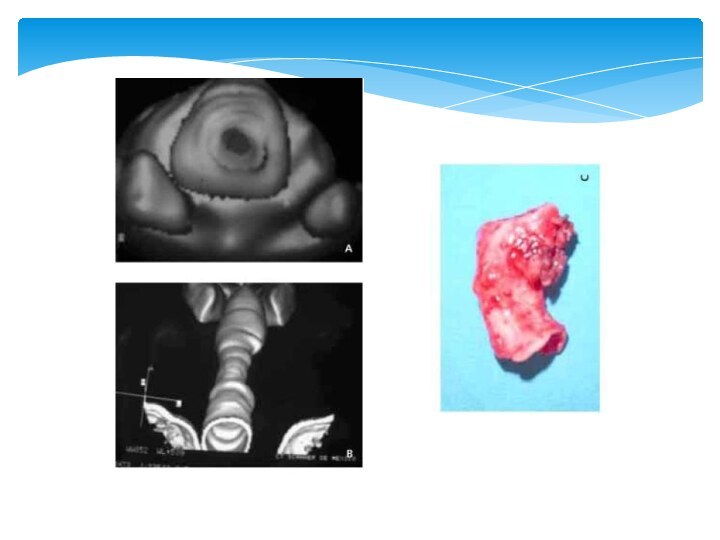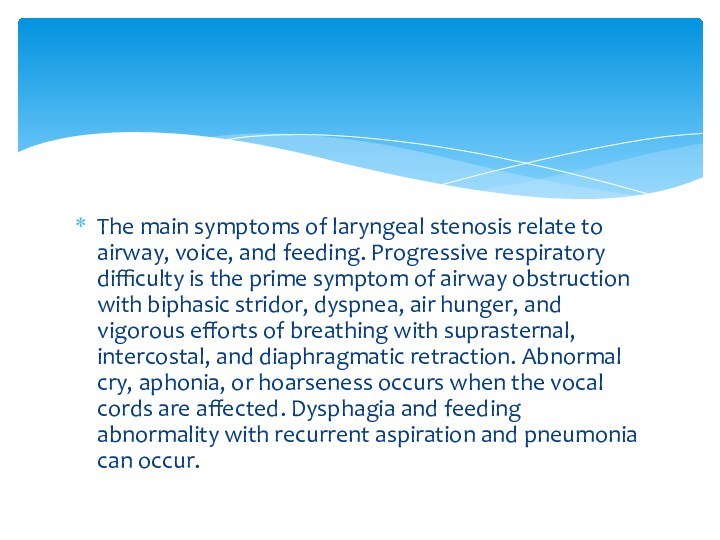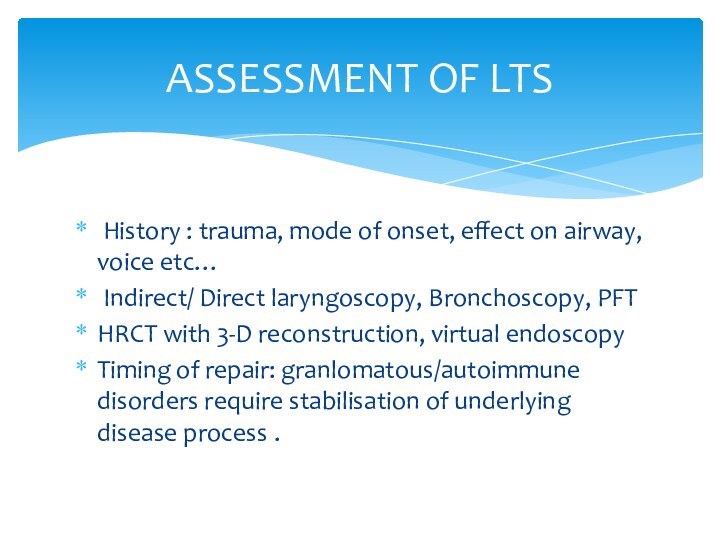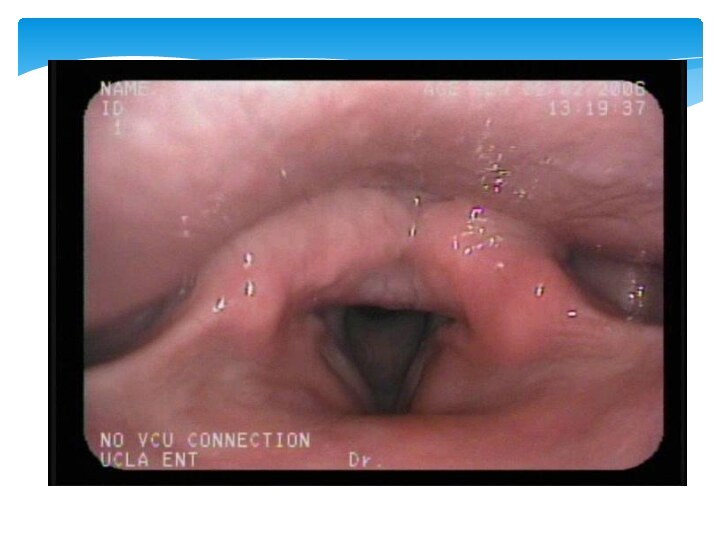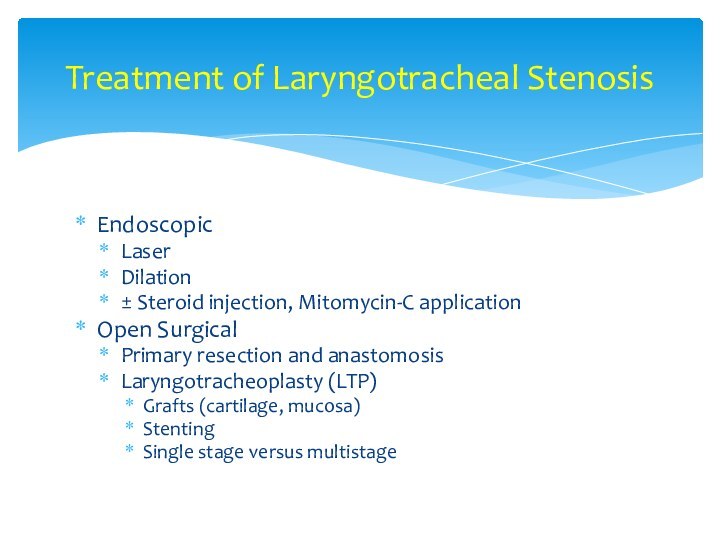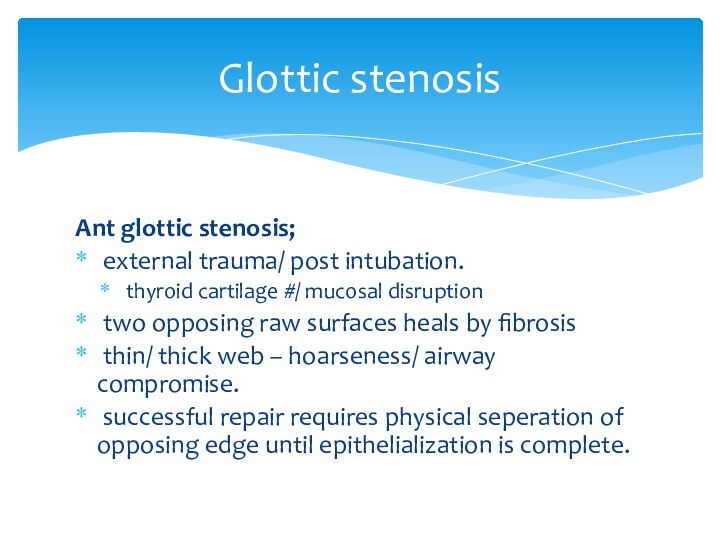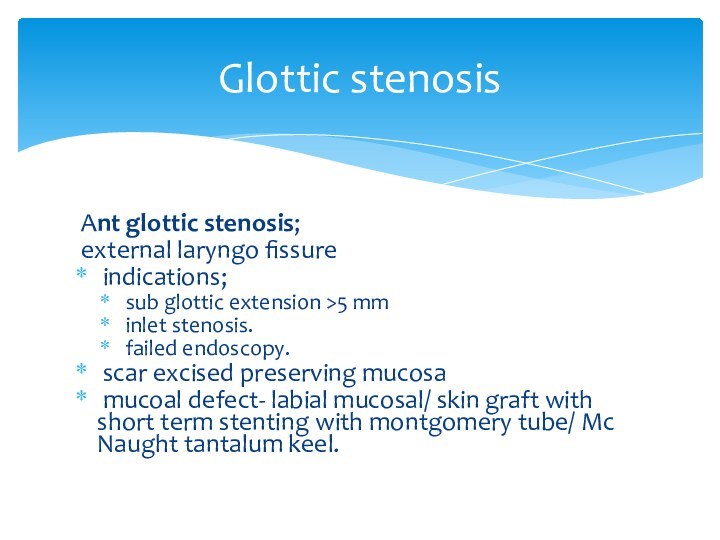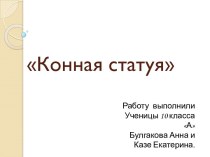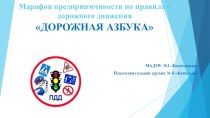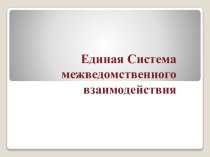Слайд 2
Laryngeal edema
Laryngeal edema is a common cause of
airway obstruction in the recently extubated intensive care unit
(ICU) patient. Depending upon the severity of edema, patients may go on to develop “a high pitched noisy respiration” known as “stridor”
(1). Stridor has been documented to occur in 3.5-36.8% of the ICU population, depending on the definition used
(2). Stridor not only leads to anxiety for the patient and family, but may progress to acute respiratory failure requiring reintubation and resulting in increased mechanical ventilation days, ICU days, patient care costs, morbidity, and mortality.
Слайд 4
Infections:
epiglottitis, laryngo trachea bronchitis, tuberculosis or
syphylisnof larynx
Infections in neighbourhood
peritonsillar abscess, retropharyngeal abscess,
ludwings angina
Trauma
surgery of tongue, laryngeal trauma, endoscopy, inhalation, irritant gases, thermal, chemical burns, intubation
Neoplasm Cancer of larynx or laryngopharynx
often assoc iated with deep ulceration
Allergy
angioneurotic edema, anaphylaxis
Radiation: For cancer of larynx or pharynx.
Systemic disease : Nephritis, heart failure, or
myxoedema.
Etiology
Слайд 5
Airway obstruction
Inspiratory stridor
Diagnostics
Indirect laryngoscopy shows oedema of
supraglottic
or subglottic region. Children may require direct
laryngoscopy.
Symptoms and signs
Слайд 7
Intubation/ tracheostomy
Steroids (thermal, chemical)
Adrenaline (1:1000) i/m 0,3-0,5ml repeated
every 15 minutes
Steroids are useful in
epiglottitis, laryngo- tracheo-bronchitis or
oedema due to
traumatic allergic or post-radiation causes.
Management
Слайд 8
Level 1: Steroid therapy decreases post-extubation stridor and
need for reintubation in patients at increased risk for
extubation failure due to airway edema. Steroid therapy should be administered >6 hours prior to extubation to be effective in reducing airway edema.
Level 2: Patients at risk for laryngeal edema include: Traumatic intubation Female gender Prolonged intubation (>7 days) Traumatic injury Oversized endotracheal tubes Self extubation Failed cuff leak test The cuff leak test is an adequate test to assess for laryngeal edema.
Level 3: A leak of greater than 30% of the administered tidal volume upon deflation of the endotracheal tube cuff is suggestive of successful extubation. When steroids are administered to decrease post-extubation stridor, dexamethasone 4 mg IV q 6 hrs should be utilized.
Managenment
Слайд 9
Laryngeal stenosis is a congenital or acquired narrowing
of the airway that may affect the supraglottis, glottis,
and/or subglottis. It can be defined as a partial or circumferential narrowing of the endolaryngeal airway and may be congenital or acquired. The subglottis is the most common site of involvement.
Laryngeal stenosis
Слайд 10
ETIOLOGY
1.Trauma:
External
blunt
penetrating
Internal
intubation
post tracheostomy
post surgery
post radiotherapy
thermal/ chemical burns
Слайд 11
ETIOLOGY
2. Chronic inflammatory disease
tuberculosis/ leprosy
sacoidosis
scleroma
histoplasmosis
diphtheria
syphilis
3. Benign disorders
intrinsic
papilloma/chondroma
minor salivary
gland / nerve sheath tumor
extrinsic
Thyroid/ thymic tumors
Слайд 12
ETIOLOGY
4. Malignant disorders
Intrinsic
SCC/ minor salivary gland
tumor
sarcoma/ lymphomas
Extrinsic
Thyroid malignancy
5. Collagen vascular
disorders
Wegeners granulomatosis
Relapsing poly chondritis
Слайд 13
PATHOPHYSIOLOGY
Knowledge of pathophysiologyy is essential that it
gives idea regarding time/ frequency of intervention, surgical procedure
required and its outcome.
Endotracheal intubartion
ischemic necrosis ( pressure )
mucosal ulcer+ inflammation = fibrosis
others: duration, composition/ size of tube, laryngeal movement.
primary site ; post glottis.
Слайд 14
PATHOPHYSIOLOGY
External trauma
disruption of cartilagenous framework
hematoma/
mucosal disruption
hematoma:
cartilage loss
heals by fibrosis
secondary
infection
OTHERS:
DM, CCF, stroke, GERD.
idiopathic- females (estrogen- TGFβ ).
Слайд 15
CLASSIFICATION
COTTONS system of grading
Слайд 16
CLASSIFICATION
Post glottic stenosis (bogdasarin & olson)
TYPE 1 vocal
process adhesion
TYPE 2 post commissure stenosis with
interarytenoid plane
scarring.
TYPE 3 post commissure stenosis with
ankylosis of unilat crico arytenoid joint
TYPE 4 post commissure stenosis with bilateral
cricoarytenoid joint ankylosis.
Слайд 17
CLASSIFICATION
Mc Caffery ( clinical status )
GRADE
1-subglottic / tracheal stenosis
subglottic stenosis <1 cm within
cricoid ring without glottic / tracheal
extension.
GRADE 3-subglottic leison with extn upto upper
trachea but no glottic involvement.
GRADE 4-glottic involvement with fixation/
paralysis of one/ both vocal folds.
Слайд 20
Stridor is a common presenting sign in laryngeal
obstruction. Supraglottic or glottic obstruction generally presents as inspiratory
stridor, while narrowing between the glottis through the trachea is associated with biphasic stridor.
Other symptoms include episodes of apnea, suprasternal and subcostal retractions, tachypnea, and dyspnea. Hypoxia can result in cyanosis and anxiety. If the glottis is involved, symptoms of hoarseness or weak husky cry, aphonia, or dysphagia may be noted.
Manifestation
Слайд 21
The main symptoms of laryngeal stenosis relate to
airway, voice, and feeding. Progressive respiratory difficulty is the
prime symptom of airway obstruction with biphasic stridor, dyspnea, air hunger, and vigorous efforts of breathing with suprasternal, intercostal, and diaphragmatic retraction. Abnormal cry, aphonia, or hoarseness occurs when the vocal cords are affected. Dysphagia and feeding abnormality with recurrent aspiration and pneumonia can occur.
Слайд 22
ASSESSMENT OF LTS
History : trauma, mode of
onset, effect on airway, voice etc…
Indirect/ Direct laryngoscopy,
Bronchoscopy, PFT
HRCT with 3-D reconstruction, virtual endoscopy
Timing of repair: granlomatous/autoimmune disorders require stabilisation of underlying disease process .
Слайд 23
Radiologic evaluation Radiologic evaluation is performed after stabilization

of the airway. Radiography helps assess the exact site
and length of the stenotic segment, especially for totally obliterated airways.
Endoscopy Indirect laryngoscopy alone is inadequate for diagnosis. Direct endoscopic visualization of the larynx is essential to study the stenosis carefully. Flexible fiberoptic endoscopy assesses the dynamics of vocal cord function and the upper airway, including the trachea (Vauthy and Reddy, 1980). In patients with severe burns with neck contractures, flexible endoscopy may be the only method to visualize the larynx. Flexible retrograde tracheoscopy through the tracheostomy site may add some useful information in some cases.
Psychoacoustic evaluation and acoustic analysis of the voice may be used to establish the degree of vocal abnormality before surgery and compare it after surgery (Dedo and Rowe, 1983; Zalzal et al, 1991). Videostrobolaryngoscopy helps in assessment of vocal cord function in adults. 12 Pulmonary function tests with either the spirometric maximum inspiration and expiration flow rates, flow volume loops, or pressure flow loops show characteristic changes in upper airway stenosis and can be used to compare the postoperative results with preoperative values (Brookes and Fairfax, 1982; Grahne et al, 1983; Hallenborh et al, 1982; Zalzal et al, 1990).
Diagnostics
Слайд 24
New Technology
Trans-nasal “Esophagoscope”
Expanded diagnostic endoscopy
Laryngoscopy
Bronchoscopy
Esophagoscopy
2.0 mm Working
Channel
Biopsies
Injections
Procedures
TEP
Слайд 25
SURGICAL MANAGEMENT
SUPRA GLOTTIC STENOSIS ;
injury can be
epiglottis adherent to post / lateral hypopharyngeal wall.
hyoid # - displaced posteriorly with epiglottis = inlet stenosis.
horizontal web of post hypo pharyngeal wall at level of superior aspect of epiglottis.
Approach; trans hyoid pharyngotomy.
Слайд 27
Not all stenosis need to be treated!
Слайд 28
Treatment of Laryngotracheal Stenosis
Endoscopic
Laser
Dilation
± Steroid injection, Mitomycin-C application
Open
Surgical
Primary resection and anastomosis
Laryngotracheoplasty (LTP)
Grafts (cartilage, mucosa)
Stenting
Single stage versus
multistage
Слайд 29
Supra glottic stenosis treatment
trans hyoid pharyngotomy;
horizontal
skin incision( hyoid bone )
if hyoid # (
reduced& fixed, removed )
vallecula entered.
adhesion of epiglottis to post / lat wall
division along long axis.
sub mucosal excision of scar.
primary mucosal closure.
horizontal web
vertical incision – scar excised.
mucosal flaps undermined- horizontal line closure
Слайд 30
Supra glottic stenosis treatment
In case of extensive
mucosal defect – skin graft.
Full thickness loss –
radial forearm flap.
In case of post displacement of hyoid/ epiglttic cartilage,
laryngofissure
base of epiglottis identified.
ant fascia, perichondrium ,& epiglottis incised inverted V shape.
Mucoperichondrium of epiglottis elevated superiorly.
Scar tissue ,base of epiglottis excised
Mucoperichondrium incised & flaps turned outward and sewn to ant epiglottis
Thyrotomy closed.
Слайд 31
Glottic stenosis
Ant glottic stenosis;
external trauma/ post intubation.
thyroid cartilage #/ mucosal disruption
two opposing raw
surfaces heals by fibrosis
thin/ thick web – hoarseness/ airway compromise.
successful repair requires physical seperation of opposing edge until epithelialization is complete.
Слайд 32
Glottic stenosis
Ant glottic web ;
MLS /
CO2 laser excision – keel insertion
keel inserted –
endoscopically /mini cricho thyrotomy
Ideal keel ;
stable, inert
extension- cricho thyriod membrane to 2-3 mm above ant commissure.
post wing at vocal process not in post commissure.
if extends above petiole, angle should be 120^.
Слайд 33
Glottic stenosis
Ant glottic stenosis;
external laryngo fissure
indications;
sub glottic extension >5 mm
inlet stenosis.
failed endoscopy.
scar excised preserving mucosa
mucoal defect- labial mucosal/ skin graft with short term stenting with montgomery tube/ Mc Naught tantalum keel.
Слайд 34
Glottic stenosis
Post glottic stenosis;
cause – post
intubation (most common)
_ cricho arytenoid joint arthritis.
repair
endoscopic excision of web.
Co2 laser.
laryngofissure- submucosal excision of scar
endoscopic laser arytenoidectomy (type 4 )
Post crichoid split with rib cartilage grafting.
Слайд 36
Glottic stenosis
complete glottic stenosis;
laryngofissure ( main
stay of treatment )
Stenosis divided at midline.
scar excised
preserving mucosa & developing mucosal flap from AEF.
If extensive area is devoid of mucosa- grafting (buccal mucosa, septal mucosa, SSG, ) is done.
Graft sutured in place and stent kept.
Stent removed at a later date.
Слайд 37
Glottic stenosis
Alternative approach;
Epiglottic flap
indication
severe glottic
stenosis with 50% reduction in A-P diameter of glottis.
midline thyrotomy
submucosal scar excision
base of epiglottis identified.
epiglottis pulled inferiorly to crichoid arch and sutured to thyroid (lat ) , crichoid (inferiorly ).
Слайд 38
Subglottic stenosis
ENDOSCOPIC METHODS
Co2 laser
micro debrider.
Co2
laser excision and repair with micro trap door flap
– circumferrential sub glottic stenosis.
Radial incision at 12, 3, 6, 9 O’ clock position – bronchoscopic dilatation.
Слайд 40
Subglottic stenosis
EXTERNAL APPROACH;
scar resection and SSG grafting.
hyoid sterno hyoid muscle interposition graft .
thyroid sterno
thyroid pedicle graft.
costal cartilage / septal cartilage grafting
post crichoid lamina split & internal rigid stenting.
partial cricoid resection with thyro tracheal anastomosis.
risk RLN injury.
need for laryngeal release.
neck kept in complete flextion in post – op.
Слайд 42
LTS IN PEDIATRIC AGE GROUP
ANATOMY;
situated at
a higher level
funnel shape; midcricoid area 2-3 mm
below cords narrowest.
small and narrow lumen.
mucosa has loose areolar tissue with abundant sub mucosal fluid.
Слайд 43
LTS IN PEDIATRIC AGE GROUP
ETIOLOGY;
congenital
cong
sub glottic stenosis
vocal cord paralysis
sub glottic hemangioma
laryngomalacia/ tracheomalacia.
acquired
inflammatory
neoplastic
traumatic
Слайд 44
LTS IN PEDIATRIC AGE GROUP
MANAGEMENT;
endoscopic
open
techniques
ant cricoid split
laryngo tracheoplasty
laryngo tracheal reconstruction
crico tracheal resection and anastomosis
Слайд 45
LTS IN PEDIATRIC AGE GROUP
POST OP MANAGEMENT;
antibiotic cover
anti reflux medication 6 wk
endoscopy- granulation
removal
stent removal 6-8 wks
anastomotic complications;
granulations
stenosis
dehiscence
Слайд 46
RESTENOSIS
PREVENTION;
steroids,mitomycin-c
anti reflux/ antibiotics
tissue engineering techniques
fetal fibroblasts transposition( IL6,8)
tissue engineered scaffolds (hyaluronic acid/
caboxy methyl cellulose )
marlex mesh tube covered with collagen sponge.
